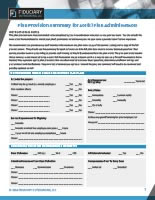
The Story
The Tabby Cat Food Producers 401(k) Plan imposed a six-month wait on new hires before they could enter the plan. However, in 2014 the newly hired Human Resource Manager decided that the eligibility waiting period should be changed to three months effective July 1st of that year. Unfortunately, she didn’t realize that she should notify the service provider in charge of plan documents of the change. So, no plan amendment was done to align the plan’s operation with the plan document.
How did they fix it?
Tabby Cat Food Producers works with its ERISA legal counsel to determine how best to fix this mistake. Since the plan document was never amended to change eligibility, the plan has two options. It can return the money contributed to all affected participants for the three months the participants saved before they should have…or…it can amend the plan retroactively to 2014 to reflect the change in plan eligibility effective July 1, 2014. The fiduciaries for the Tabby Cat plan decide that it would be better to pay to amend the plan than to return money to affected participants. So, they retain legal counsel to do the retroactive amendment.
The client’s ERISA attorney prepares a voluntary correction program submission for the IRS along with the retroactive amendment. Six weeks later, the IRS issues a compliance letter to Tabby Cat Food Producers agreeing that the retroactive amendment is acceptable and the adoption of that amendment brings the plan back into compliance. In a matter of a few weeks, Tabby Cat Food Producers successfully solved its problem of failing to follow the plan’s terms without negatively impacting plan participants. The cost to correct amounted to the preparation of the VCP submission, the IRS user fee and the retroactive amendment.
How did they avoid doing it again?
The CEO of Tabby Cat Food Producers was relieved the correction of this mistake was easy but also concerned that another mistake could easily be made and potentially be much more expensive to fix. A review of the responsibilities of the Human Resource Manager determined there were other needs for her expertise. After further discussions with their ERISA attorney, Tabby Cat Food Producers hired Fiduciary Outsourcing as their fiduciary Plan Administrator to outsource these responsibilities for the plan and prevent future mistakes.

The Mistake
Every 401(k) plan has a legal plan document. That document indicates exactly how the plan will work.
It includes information such as:
- When newly employed individual will become eligible for the plan
- What compensation will be used to calculate contributions
- What contributions can be made to the plan and how are those contributions determined
- When can an employee withdraw money from the plan
Newly hired employees should be provided with a summary of the plan document provisions, called a Summary Plan Description. The various service providers to the plan should also be provided with a copy of the plan document so they can assist in administering the plan properly.
Because the employees automatically get a copy of the Summary Plan Description, and have the right to request a copy of the full plan document, the plan document effectively acts as a contract between the company and the employees. It’s imperative to follow the terms of the contract or in our case the plan document.
However, plans tend to get administered similarly to the childhood game of telephone. The first person trained at your company tells the second person to be trained who tells the third person to be trained and before you know it the original sentence “The sky is blue” has turned into “Achoo”. We tend to train people verbally, not by having them read the really boring legal plan document. So, things get distorted. As a result, it’s very common for plans not to be administered in accordance with the terms of their plan documents.

What Happens
The answer to this question depends on which provisions of the plan you failed to follow.
There are many common mistakes such as:
- Letting someone into the plan too early or to late
- Using the wrong compensation
- Calculating contributions incorrectly
- Administering automatic enrollment incorrectly
- Allowing too much money out as a distribution
- Anything to do with loans
Common mistakes are easily corrected by submitting the plan to the IRS using its Voluntary Correction Program. An attorney or consultant will generally determine the method the IRS wants you to use to correct the common mistake, calculate any contributions that might be due, prepare the necessary paperwork for the IRS and then discuss the issue with the IRS to obtain for you a closing agreement that the plan is back in compliance.
Less common mistakes can occur as well. Most mistakes can be corrected using the Voluntary Correction Program, but the answer might not always be obvious as to how to correct the mistake. In this case, an ERISA attorney or a retirement plan consultant is critical to the process to determine the best method of correcting a plan error. Sometimes, plan errors are submitted anonymously to the IRS so a solution can be worked out without the IRS finding out who you are until a negotiated solution has been reached. These anonymous submissions must use a retirement plan expert since you cannot submit an anonymous submission yourself…it kind of defeats the purpose of being anonymous.
In the end, for the cost of services of the ERISA attorney or the consultant plus the IRS fee for asking forgiveness, you will be forgiven for almost any mistake where you failed to follow the terms of the plan document, as long as you actually fix the problem.
Avoid it
Best practice to avoid failing to follow the terms of the plan document would be to actually have everyone working on the plan read the plan document. In the real world, that probably won’t work. Realistically, a plan document is 200+ pages of legal language and Internal Revenue Code references that work best for curing insomnia but not for actually understanding how a plan is supposed to work.
A professional fiduciary administrator assigns someone to read the plan document and create written procedures for their staff to use. The staff are then required to follow those written procedures. Any variance from the procedures can only occur with approval of the person who read the plan document and wrote the procedures, and then only very rarely.
Written procedures ensure that everyone follows the terms of the plan document. Regular review of those procedures, especially if an amendment is done to the plan, ensure that the procedures are prudent and follow the plan document provisions. In this way, errors in following plan terms can be kept to a minimum.
If in doubt, consult the plan document. That may mean asking what something means from the plan’s service provider team.

How We Help
You can retain Fiduciary Outsourcing as the Plan Administrator for your plan. If you can provide us with sufficient access to the plan and payroll information, you can outsource the vast majority of your staff’s current responsibilities to the Plan. This leaves us in the position of being the determining body that ascertains the plan is being administered properly. If engaged in this capacity, we become the named Plan Administrator in the plan document making us the plan’s primary administrative fiduciary.

Checklist
Download the Plan Provision Summary for 401(k) Plan Administrators, an ease of use tool for plan participants.

The Story
The Tabby Cat Food Producers 401(k) Plan imposed a six-month wait on new hires before they could enter the plan. However, in 2014 the newly hired Human Resource Manager decided that the eligibility waiting period should be changed to three months effective July 1st of that year. Unfortunately, she didn’t realize that she should notify the service provider in charge of plan documents of the change. So, no plan amendment was done to align the plan’s operation with the plan document.
How did they fix it?
Tabby Cat Food Producers works with its ERISA legal counsel to determine how best to fix this mistake. Since the plan document was never amended to change eligibility, the plan has two options. It can return the money contributed to all affected participants for the three months the participants saved before they should have…or…it can amend the plan retroactively to 2014 to reflect the change in plan eligibility effective July 1, 2014. The fiduciaries for the Tabby Cat plan decide that it would be better to pay to amend the plan than to return money to affected participants. So, they retain legal counsel to do the retroactive amendment.
The client’s ERISA attorney prepares a voluntary correction program submission for the IRS along with the retroactive amendment. Six weeks later, the IRS issues a compliance letter to Tabby Cat Food Producers agreeing that the retroactive amendment is acceptable and the adoption of that amendment brings the plan back into compliance. In a matter of a few weeks, Tabby Cat Food Producers successfully solved its problem of failing to follow the plan’s terms without negatively impacting plan participants. The cost to correct amounted to the preparation of the VCP submission, the IRS user fee and the retroactive amendment.
How did they avoid doing it again?
The CEO of Tabby Cat Food Producers was relieved the correction of this mistake was easy but also concerned that another mistake could easily be made and potentially be much more expensive to fix. A review of the responsibilities of the Human Resource Manager determined there were other needs for her expertise. After further discussions with their ERISA attorney, Tabby Cat Food Producers hired Fiduciary Outsourcing as their fiduciary Plan Administrator to outsource these responsibilities for the plan and prevent future mistakes.

The Mistake
Every 401(k) plan has a legal plan document. That document indicates exactly how the plan will work.
It includes information such as:
- When newly employed individual will become eligible for the plan
- What compensation will be used to calculate contributions
- What contributions can be made to the plan and how are those contributions determined
- When can an employee withdraw money from the plan
Newly hired employees should be provided with a summary of the plan document provisions, called a Summary Plan Description. The various service providers to the plan should also be provided with a copy of the plan document so they can assist in administering the plan properly.
Because the employees automatically get a copy of the Summary Plan Description, and have the right to request a copy of the full plan document, the plan document effectively acts as a contract between the company and the employees. It’s imperative to follow the terms of the contract or in our case the plan document.
However, plans tend to get administered similarly to the childhood game of telephone. The first person trained at your company tells the second person to be trained who tells the third person to be trained and before you know it the original sentence “The sky is blue” has turned into “Achoo”. We tend to train people verbally, not by having them read the really boring legal plan document. So, things get distorted. As a result, it’s very common for plans not to be administered in accordance with the terms of their plan documents.

What Happens
The answer to this question depends on which provisions of the plan you failed to follow.
There are many common mistakes such as:
- Letting someone into the plan too early or to late
- Using the wrong compensation
- Calculating contributions incorrectly
- Administering automatic enrollment incorrectly
- Allowing too much money out as a distribution
- Anything to do with loans
Common mistakes are easily corrected by submitting the plan to the IRS using its Voluntary Correction Program. An attorney or consultant will generally determine the method the IRS wants you to use to correct the common mistake, calculate any contributions that might be due, prepare the necessary paperwork for the IRS and then discuss the issue with the IRS to obtain for you a closing agreement that the plan is back in compliance.
Less common mistakes can occur as well. Most mistakes can be corrected using the Voluntary Correction Program, but the answer might not always be obvious as to how to correct the mistake. In this case, an ERISA attorney or a retirement plan consultant is critical to the process to determine the best method of correcting a plan error. Sometimes, plan errors are submitted anonymously to the IRS so a solution can be worked out without the IRS finding out who you are until a negotiated solution has been reached. These anonymous submissions must use a retirement plan expert since you cannot submit an anonymous submission yourself…it kind of defeats the purpose of being anonymous.
In the end, for the cost of services of the ERISA attorney or the consultant plus the IRS fee for asking forgiveness, you will be forgiven for almost any mistake where you failed to follow the terms of the plan document, as long as you actually fix the problem.
Avoid it
Best practice to avoid failing to follow the terms of the plan document would be to actually have everyone working on the plan read the plan document. In the real world, that probably won’t work. Realistically, a plan document is 200+ pages of legal language and Internal Revenue Code references that work best for curing insomnia but not for actually understanding how a plan is supposed to work.
A professional fiduciary administrator assigns someone to read the plan document and create written procedures for their staff to use. The staff are then required to follow those written procedures. Any variance from the procedures can only occur with approval of the person who read the plan document and wrote the procedures, and then only very rarely.
Written procedures ensure that everyone follows the terms of the plan document. Regular review of those procedures, especially if an amendment is done to the plan, ensure that the procedures are prudent and follow the plan document provisions. In this way, errors in following plan terms can be kept to a minimum.
If in doubt, consult the plan document. That may mean asking what something means from the plan’s service provider team.

How We Help
You can retain Fiduciary Outsourcing as the Plan Administrator for your plan. If you can provide us with sufficient access to the plan and payroll information, you can outsource the vast majority of your staff’s current responsibilities to the Plan. This leaves us in the position of being the determining body that ascertains the plan is being administered properly. If engaged in this capacity, we become the named Plan Administrator in the plan document making us the plan’s primary administrative fiduciary.

Checklist
Download the Plan Provision Summary for 401(k) Plan Administrators, an ease of use tool for plan participants.

